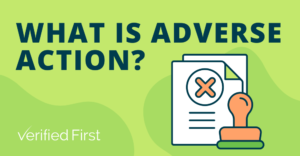
Your organization likely uses background checks during the hiring process to review a candidate’s criminal record, work experience, education history, and more. Ideally, this step results in finalizing an applicant’s job offer — however, that is not always the case. When the results of background screening negatively impact employment consideration, organizations must follow the adverse action process before making a final hiring decision.
With so much pressure on employers to hire quickly and provide a smooth candidate experience, failure to properly follow the adverse action process can expose you to legal risk resulting in hefty fines and reputational damage. This article discusses what the adverse action process is and how employers can navigate it.
You may have heard of adverse action in terms of banks and credit scores. Federal law requires lenders to provide individuals with adverse action notices if their credit score is being adversely used against them (i.e. when turning down a loan or credit card application or charging a higher interest rate).
In terms of background screening, adverse action is any step an employer takes that negatively impacts a candidate’s employment opportunity based on the information discovered in the pre-employment screening process. Some common examples of adverse action include denying an applicant’s employment or offering an applicant a lesser position. When information that appears in a candidate’s background check leads to a decision against the individual, the federal Fair Credit Reporting Act (FCRA) requires employers to comply with a regulated adverse action process.
But why is this important? The adverse action process inherently affects individuals negatively, which means it often results in litigation and potential compliance risk. Failure to adhere to the FCRA’s adverse action procedures can lead to serious legal consequences, such as class action lawsuits and major fines. And over the last few years, employers of all sizes have faced class action lawsuits claiming various FCRA violations. In fact, in 2019, major pet supplies brand Petco agreed to pay $1.2 million to settle a lawsuit alleging the brand neglected to provide applicants with the required notices as stated by the FCRA.
If you decide not to hire a candidate based on the information uncovered in a background check report, you must initiate adverse action. Employers that choose to initiate adverse action must carefully follow the steps outlined by the FCRA. Let’s explore the three steps you must complete to stay compliant during the adverse action process:
When you choose not to hire a candidate based on their background check, you must provide the applicant with a pre-adverse action notice. This pre-adverse action notice also referred to as a pre-adverse action letter, informs the candidate that you are considering not moving forward with their employment process.
The pre-adverse action notice can be delivered via electronic or hard copy, but it must also include the following:
Once the candidate receives the pre-adverse action notice, they have the right to review the information used against them for accuracy. Some state and local laws (depending where the applicant lives) may require additional disclosures and documentation. Be sure to stay on top of regulations that may impact your organization.
Once you provide the applicant with the pre-adverse action notice, the FCRA requires you to wait a “reasonable” amount of time before sending your final decision. This waiting period gives the applicant time to review the results of their background check and dispute any inaccurate information.
The FCRA does not define what a “reasonable” amount of time is for this waiting period. Standard practice is to wait a minimum of five to seven business days before sending the official adverse action letter to your applicant. It’s important to note some states and jurisdictions may require a longer or shorter waiting period.
During this time, you should also review the candidate’s response (if applicable). If the candidate has disputed any inaccurate information, the adverse action process is paused to allow the consumer reporting agency to investigate the dispute. If you decide to not move forward with the applicant after the waiting period (or if the applicant does not dispute the findings), you can move forward with the adverse action process.
If you opt not to move forward with the candidate, you must send the individual a final adverse action notice informing them of your decision. The adverse action notice needs to inform the applicant of their right to dispute and their right to obtain another free copy of their background check report within 60 days.
If you utilize a third party, such as a consumer reporting agency, for background screening, the adverse action notice must also include the following information:
After you have provided an applicant with a compliant adverse action notice, the FCRA requires that you dispose of all sensitive information securely. The Disposal Rule outlines proper ways to destroy background checks and adverse action documentation and information, including shredding, pulverizing, or incinerating paper documents and permanently erasing digital copies so they cannot be read or reconstructed.
Issuing adverse action notices is not the most glamorous part of your job as an HR leader or hiring manager. However, it is crucial to stay in compliance with the FCRA regulations to not only offer applicants a fair and transparent process but also to protect your organization against potential risk.
Verified First allows you to automate the adverse action process to reduce manual tasks, provide transparent and positive candidate experiences, and support your compliance goals. Users can easily initiate adverse action within the Verified First portal and customize it to fit their needs.
Evaluating background check reports and initiating adverse action is time-consuming and challenging on your own. However, errors can leave your organization open to serious legal risks and liabilities. Verified First can help save you time and money, while protecting your organization and streamlining your hiring from start to finish.